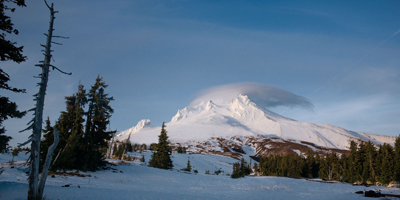 Mt. Hood
Mt. Hood
Mt. Hood’s perpetually snowy peak — crowned by eleven glaciers, one for every thousand feet it rises above sea level — can be seen from miles and miles away. It’s home to a total of six ski areas, making it a great base camp for skiers.
Historic Timberline Lodge, a WPA project built between 1936 and 1938, hosts some of the only year-round skiing anywhere on earth. The lodge’s design mirrors the lines of the mountain, and was constructed out of stone and wood from the surrounding forest. It’s also a great place to sit by the fire, have a glass of wine and marvel at the massive peak outside.
Beautiful alpine lakes with names like Lost, Trillium and Mirror dot Mt. Hood’s flanks, each offering its own unique view of the mountain.
Forests and valleys fill with lavender and wildflowers in the spring, and apples and pears and berries in the summer and fall — so much so that the epic drive between the mountain and the town of Hood River is called the Fruit Loop.
There are plenty of reasons why Mt. Hood is one of the 7 Wonders of Oregon. Go see them for yourself.
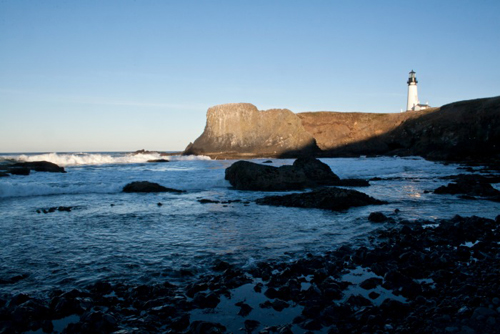 The Oregon Coast
The Oregon Coast
If you brought a swimsuit to the Oregon Coast, don’t worry, someone will loan you a sweater.
People don’t come to the Oregon Coast to work on their tans. You won’t see many bikinis on Cape Blanco or folks sitting idly with a book next to the Devil’s Punchbowl.
We don’t even call it “the beach.” We don’t come here seeking the sun. Sure, you might see it peeking through the old growth of Oswald West. But as soon as you hear the surf crashing into the cliffs, you stop paying attention to anything else.
That’s the moment you start to realize how big this all is. Troubles seem smaller and the little moments feel magnified. And as you splash in the tide pools, watch the whales, hunt for agates, explore lighthouses and wander all 363 miles of free and public coastline, you might be like, “I’m calling in sick tomorrow. I’m learning to surf.”
And someone will probably teach you, because Oregonians are just cool like that. Eventually you realize that your beach bod still looks pretty good under those layers of clothing.
Lots of places have a beach.
If you want to go to the Coast, you have to come to Oregon.
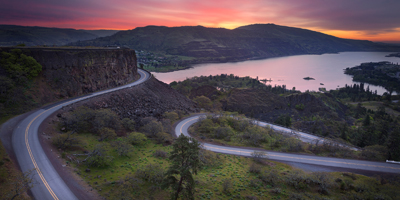 The Columbia River Gorge
The Columbia River Gorge
Just a short drive from Portland, you’ll find the amazing view from Crown Point, where you can see the mighty Columbia nestled in the Gorge unfurl before your very eyes.
Multnomah Falls and dozens of other falls like Horsetail, Ponytail and Bridal Veil line the way along the Historic Columbia River Highway. In the town of Hood River, you’ll find hand-scooped ice cream, hand-crafted beer, windsurfing, kiteboarding and parasailing. There’s the view from Rowena Crest, the loop up and around Dog Mountain and browsing the shelves of the oldest bookstore in all of Oregon in The Dalles.
Thanks to its unique geography, the Gorge boasts a world of wine in just a 40-mile stretch. You’ll find pinot noir and chardonnay in the cool hills at the west end, while tempranillo and syrah thrive in the drier, sunnier east.
US Congress recognized the unique splendor of the Gorge and designated it a National Scenic Area, the largest in America. And when you see it for yourself, you’ll understand why it’s one of the 7 Wonders of Oregon.
 Painted Hills
Painted Hills
When you travel to the Painted Hills, you can see millions of years of history revealed in the layers of mountains of earth, one color at a time. The hills get their name from the delicately colored stratifications in the soil and the yellows, golds, blacks and reds of the Painted Hills are best seen in the late afternoon. Tones and hue may appear to change from one visit to another, as the claystones differ with ever-changing light and moisture levels. Once you see them for yourself, it’s pretty easy to understand why the Painted Hills are one of the 7 Wonders of Oregon.
The Painted Hills are one of the three units that comprise the John Day Fossil Beds. Take time to also visit the Clarno Unit, with Mars-like pillars formed by waterfalls and volcanic sludge, and the Sheep Rock Unit, where fossils of plants and animals like saber-toothed cats are on display at the Thomas Condon Paleontology Center. Scientists study 50 million years of plant and animal evolution and a collection of 40,000 fossils here, and you can learn how early cousins of elephants and rhinos roamed the earth you’re standing on. To get there, take the Journey Through Time Scenic Byway through the ghost town of Shaniko, then on to the town of Fossil (named after the mammoth bone found there), where you can dig for your own fossilized souvenir. Plan to stop at the Kam Wah Chung and Co. Museum, a perfectly preserved drugstore from a century ago.
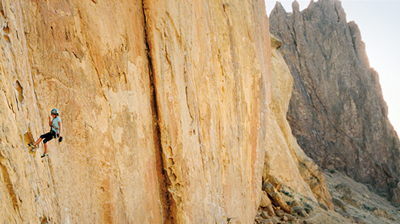 Smith Rock
Smith Rock
At Smith Rock, towers of volcanic ash rise like the spires of a cathedral out of the sage and dust of the high desert at the birthplace of American sport climbing. Whether you come for the climb or come to unwind, you’ll see why Smith Rock is one of the 7 Wonders of Oregon.
Thousands of routes attract climbers from every part of the globe, including more than a thousand bolted routes. Cliffs of tuff and basalt are ideal for rock climbing of all difficulty levels. There is sport climbing, traditional climbing and bouldering. Hiking and mountain biking and opportunities to spot golden eagles, prairie falcons, river otter and beaver in the park attract even those who don’t come for the climb.
Situated in Central Oregon, home to 300 days of sun a year, Smith Rock is located in an outdoor adventurer’s playground. Golfing, caving, paddle boarding on the Deschutes and skiing Mt. Bachelor are all close by. Mountain bikers can hit Phil’s Trail, while cyclists can take their pick of five scenic bikeways with names like Madras Mountain Views and Sisters to Smith Rock. Hikers will want to explore the obsidian lava flows at Newberry Crater National Volcanic Monument, where astronauts trained to walk on the moon. And craft beer fans, you have your pick of 24 breweries and counting in Central Oregon – 17 in Bend alone.
Smith Rock is a popular attraction and parking can be challenging, especially during the peak season and weekends. Beat the crowds and visit Smith Rock on a weekday. Respect the uniqueness and fragility of this natural wonder and stay on marked trails. Take photographs and leave only footprints.
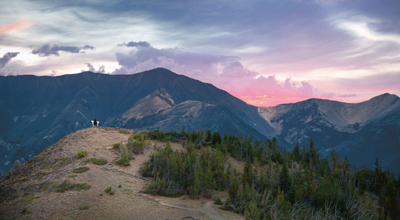 The Wallowas
The Wallowas
In the Wallowas, you can look down from an alpine summit and see the high desert of Indian country roll out in front of you in one direction, and then turn around and see past Hells Canyon into the next state, and some say all the way past it to the next one after that.
You can hike or ride a horse to the summit, but the fastest way to the top is the gondola that rises 3,700 feet from Wallowa Lake Village to the peak of Mt. Howard.
You can and should bring the whole family. Cabins and camping and mini-golf abound around Wallowa Lake. Towns like Joseph and Enterprise offer art galleries, shopping and food and drink, including handcrafted beer, craft distilleries and chocolatiers.
And then there’s the land, carved by the Oregon Trail and hardly changed since pioneers crossed by wagon. It’s bordered by the Snake River, working ranches, the remote Eagle Cap Wilderness and the wide open spaces that Eastern Oregon is known for.
There are fields of fauna, as well as clearings, some of which became towns, a few of which are now inhabited only by ghosts.
Once you see them for yourself, it’s pretty easy to see why the Wallowas are one of the 7 Wonders of Oregon.
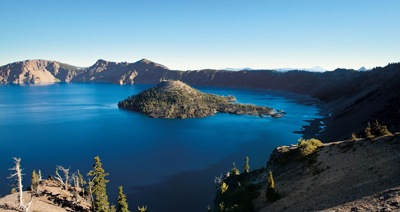 Crater Lake
Crater Lake
From high atop the rim of Crater Lake, you can see what a wonder the world really is. A hike down to the water reveals new wonders. The water is so blue, so deep, it’s no surprise it’s the deepest lake in America, and one of the deepest on earth. That’s why it’s one of the 7 Wonders of Oregon.
Surrounded by cliffs almost 2,000 feet high and boasting a picturesque island a violent volcanic past, Crater Lake is also home to hikes in old-growth forest and cross-country ski trips in the winter months. Many of the roads and facilities close during the winter, but the park is open and accessible all year long.
Crater Lake is located in Southern Oregon, which is also home to the world-renowned Oregon Shakespeare Festival, the stunning Rogue River, the Oregon Caves and vineyards, chocolatiers and cheesemakers galore.
CLIMATE: Most visitors come to Crater Lake National Park during the months of July through mid-September, when the weather is generally mild with little precipitation. Due to the elevation of the park (6,500 ft. at Park Headquarters and 7,100 ft. at Rim Village), weather conditions may change quickly and a warm jacket and wool sweater are always recommended items to carry. During the winter months, from October through June, weather conditions make preparing for extreme winter conditions necessary. Blizzards, high winds, extreme cold and low visibility dominate the weather patterns. Visitors should come with cold weather gear.
RECREATION: A good place to begin your visit to Crater Lake is at one of the two visitor centers. The Steel Information Center lies south of Rim Drive next to park headquarters and is open year-round. In the summer, the Rim Village Visitor Center is open along Rim Drive on the southern side of the caldera. After gathering information on the park and its facilities visitors can make educated decisions about what recreation opportunities to pursue. Hiking, backpacking, camping, picnicking and sight seeing are popular pursuits within the park. Boating and scenic driving around Rim Drive can be enjoyed by visitors during the summer months. In winter snowshoeing and cross-country skiing provide solitude and a little-known view of the park.
And we invite you to not just see them, but experience them. Because our Wonders aren’t just for taking pictures of – to truly say you’ve seen our Wonders, you have to get out of the car, hike down from the scenic vista and feel them beneath your feet.
Just remember: This is Oregon. So how you go about doing that is entirely up to you. For more information about trip ideas visit www.TravelOregon.com


You must be logged in to post a comment Login